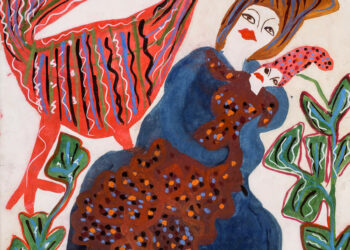On view at the Abu Dhabi Cultural Foundation is a survey exhibition by Cameroon-born, Belgium-based artist and poet Pascale Marthine Tayou. Named after Tayou’s poem LOBI LOBI, the title refers to a Lingala word describing the day before yesterday, the day after tomorrow, and soon.
LOBI LOBI …
like a dream,
a dream mirror,
an opportunity for the possible,
it is the alphabet of forbidden writing.
LOBI LOBI …
is mute,
it is the flight of Minerva,
it is the landing of an unidentified flying object,
moving on the import/export track.
LOBI LOBI …
is a showcase,
a new emergency,
this is the strictly recreational emergency,
the explosion of spices off the coasts of flavours.
LOBI LOBI …
is a temptation,
it is my need for a walk,
is walking backward away from the obvious,
is the desire to bring the rage of the margin back to the centre of the page.– LOBI LOBI by Pascale Marthine Tayou
The exhibition seeks to evoke the parallel and cyclical realities of Tayou’s practice that transcends time and territories. Featuring sculptures, mixed media, installation, poetry, and photography, the exhibition highlights the rich paradoxes of consumer and material cultures in the artist’s reformulation of his visual environment.
Working with multimedia that combines craftsmanship and found objects, Tayou’s practice reconceptualises modern reality’s societal, historical, economic, and geographic aspects. His colourful yet satirical practice stems from his “play serious” approach to unpacking the post-colonial
baggage of his immediate environment. The artist describes his visual environment as a playing field he uses to build ephemeral structures of hybridity that connect nature, the artefact, and the body. As an
active observer and player of the everyday, Tayou’s artistic process is embedded in the act of accumulation, with means to rearrange, rewire, or rectify societies’ spiritual and material significances.
The ‘Welcome Wall’ (2023) welcomes audiences to the exhibition, a window of colourful illuminated LED welcome signs in seventeen languages. This work bridges a connection between Tayou’s homage to the vast African languages and dialects and Abu Dhabi’s rich diversity of South Asian languages spoken in the city. Commonly placed on storefront windows to invite customers inside, these signs exhort openness, understanding and empathy, which are the essential tools that allow us to break down physical or invisible barriers and, thus, our own limits.
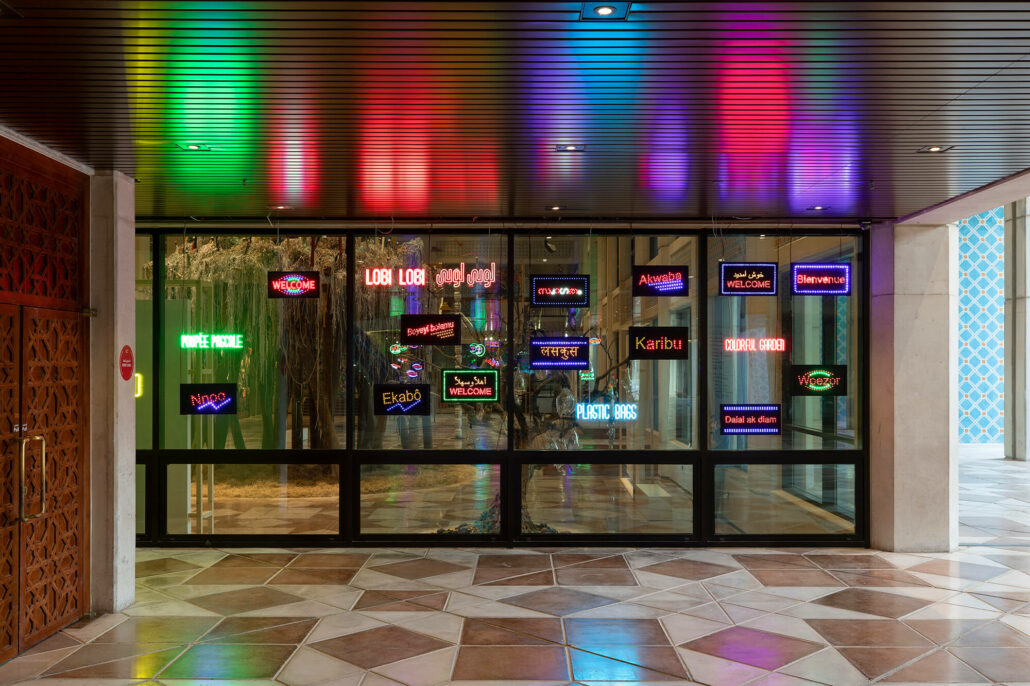
Pascale Marthine Tayou, Welcome Wall, 2023. LED signs. Dimensions variable. Courtesy of the artist and GALLERIA CONTINUA. Image courtesy: Cultural Foundation, Department of Culture & Tourism – Abu Dhabi. © ADAGP, Paris
In the imposing main foyer, themed ‘The Margin to the Centre’, monumental sculptural assemblages such as ‘Colourful Garden’ and ‘Home Sweet Home’ activate alternative methods of hybridity that restructure relations of power and mobility. What does it mean to recover from a catastrophe? Through the rivalries of resources, environmental damage, and human displacement that emerge due to global political histories, Tayou’s works unfold into a language of destruction and re-fabrication. Suspended throughout the exhibition, Tayou’s Tornado of colourful aluminium sheets points to the overwhelming sense of both amusement and loss.

Pascale Marthine Tayou, Tornado, 2023. Metal corrugated sheets. Dimensions variable. Courtesy of the artist and GALLERIA CONTINUA. Image courtesy: Cultural Foundation, Department of Culture & Tourism – Abu Dhabi. © ADAGP, Paris
Even through this calamity, Tayou offers a means of recuperation in collecting, reassorting, reshaping, and rewriting history. The works displayed in this section explore placements of the self in relation to the “other”, from the inner self to the outer world and the communal to the global. Tayou’s practice is constantly searching to hybridise nature, the artefact, and the bodily.
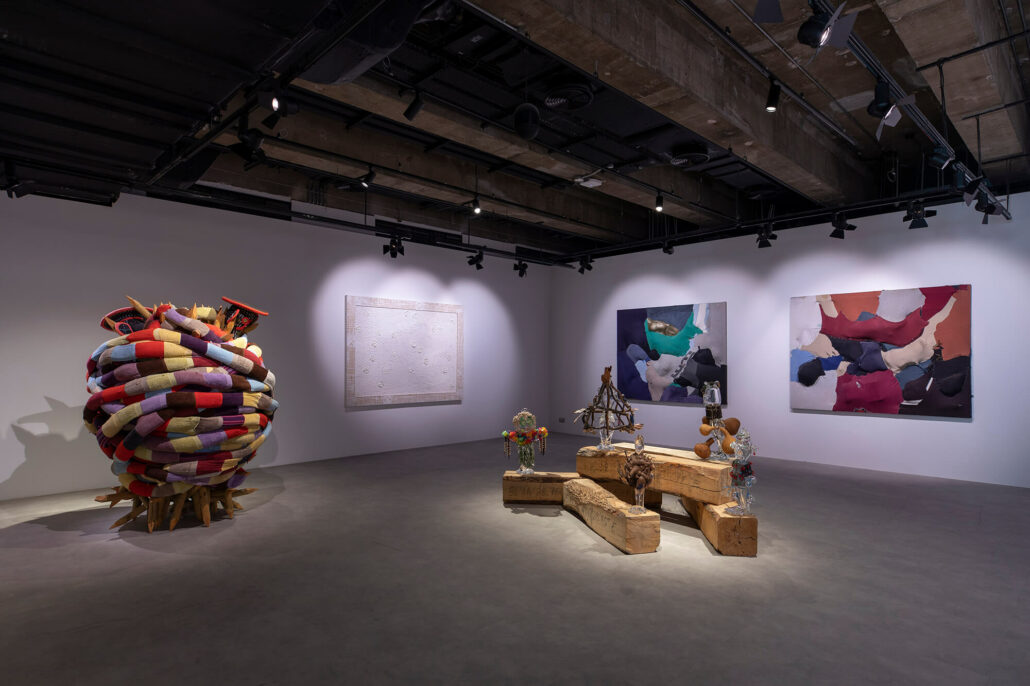
Installation view. ‘LOBI LOBI: Pascale Marthine Tayou’. Image courtesy: Cultural Foundation, Department of Culture & Tourism – Abu Dhabi.
In works like ‘Colourful Garden’ and ‘Home Sweet Home’, we see references to West Africa’s colonial history in Tayou’s incorporation of small figurines, which he calls “Flâneurs coloniaux” (aimless wanderers). Historically known as colon statues or settlers, these figurines originate from an indigenous craft practice in the Ivory Coast that emerged during the colonial period. They depicted white European colonial officials and ‘Europeanised’ African figures dressed in modern Western attire. It
is believed that these statues were set in villages and bridges to indicate to the native population the presence of European settlers. For Tayou, these sculptures are a testament to Europe’s pursuit of “exploration, civilisation, and domination”, which materialised into African craftsmanship.
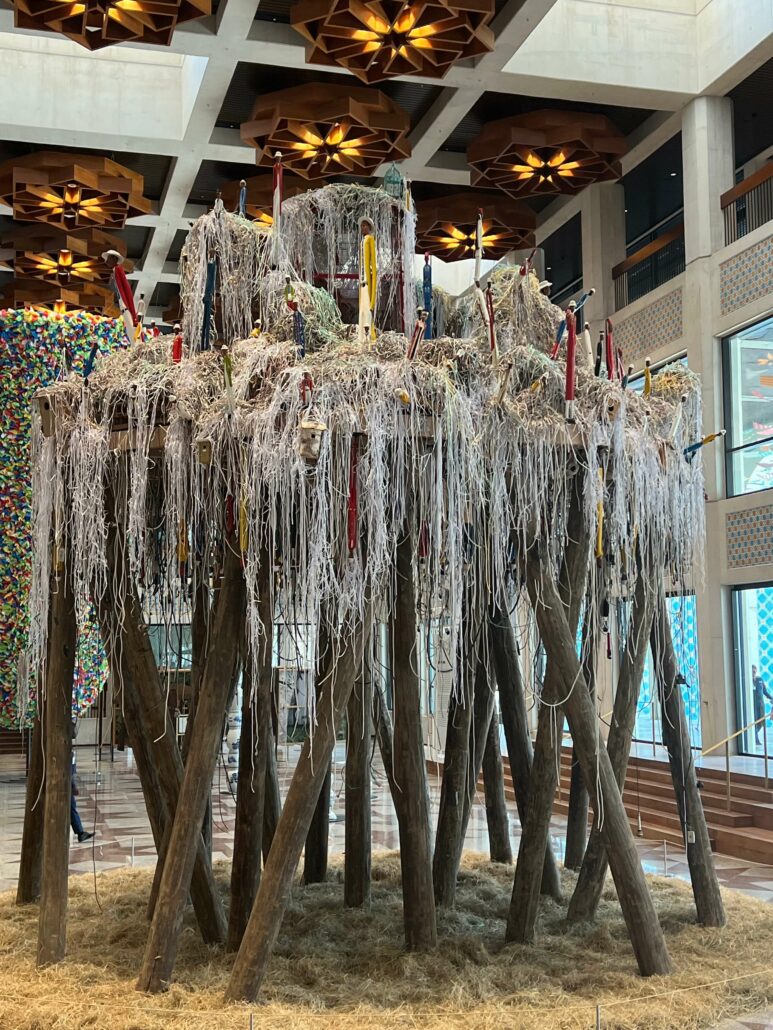
Pascale Marthine Tayou, Home Sweet Home, 2011. Tree trunks, birdcages, cables, microphones, hay. Image courtesy of Suzette Bell-Roberts
The monumental installation ‘Plastic Bags’ presents a means to reflect on the overwhelming excess of human residue, appearing in the work as sprouting blossoms. For Tayou, these sculptures are a testament to Europe’s pursuit of “exploration, civilisation, and domination”, which materialised into African craftsmanship.
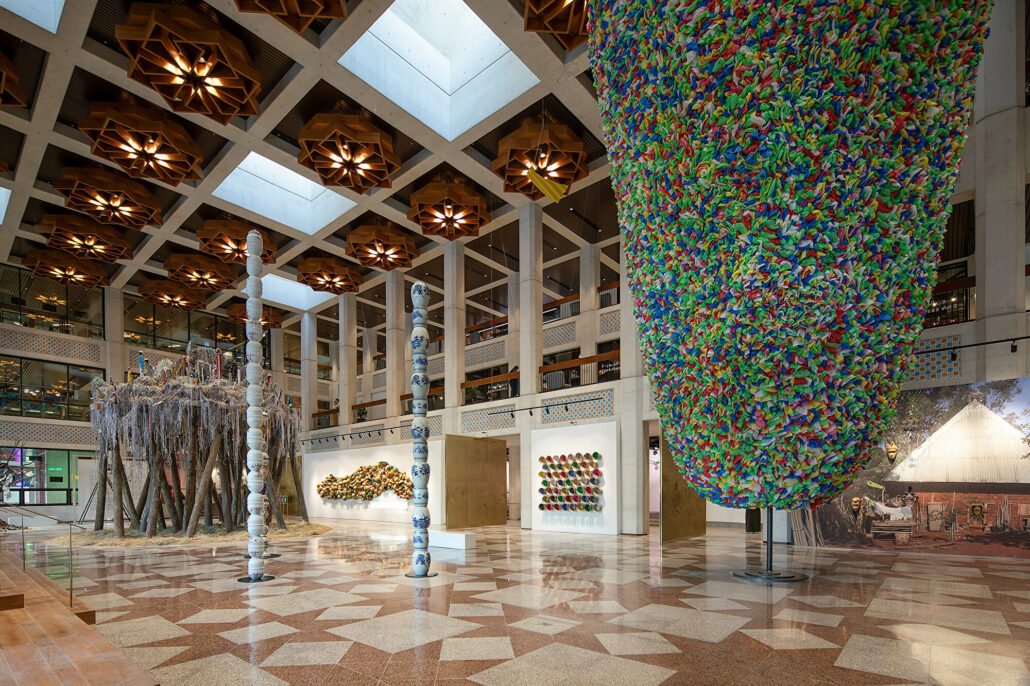
Installation view of Plastic Bags (2013). ‘LOBI LOBI: Pascale Marthine Tayou’. Image courtesy of the Cultural Foundation, Department of Culture & Tourism – Abu Dhabi.
Themed ‘Power Vessels’, the second gallery contains a display of Tayou’s clear crystal figures adorned with everyday objects from traditional African craft and found elements like plastic and scrapings from our modern globalised landscapes. Meant to evoke West-Central African nkisi nkondi or “power figures”, the artist reinterprets the concept of the nkisi, symbolised through the use of crystal; Tayou extends the power of these ancient practices into our current societies, delving into the mystery of these objects. Instead of wood, Tayou’s figures are fully transparent and made of crystal – illustrating a sense of vulnerability and contemporality. As such, they ultimately lose their ability to entrap and hide.

Pascale Marthine Tayou, Sauveteurs / Couple de supporters, 2012. Crystal and mixed media, 150 x 40 x 40cm and 130 x 40 x 40cm. Courtesy of the artist and GALLERIA CONTINUA. © ADAGP, Paris
Leading on from the previous gallery, ‘Fantasia Urbaine’ features salvaged items, which hold spiritual meanings of continuity and healing for Tayou. The interpretations of the materials result in an impactful exchange between the community, nature, and the environment.
This exchange is particularly evident in the artist’s reflection on Cameroon’s street sellers, commonly known as “sauveteurs” – a term used informally in Cameroon to describe a savvy street vendor or hawker who is always on the move.
For several years after leaving university, Tayou worked as a sauveteur. While visiting Cameroon in 2007, he learned that the municipality of Douala aimed to eliminate sauveteurs from the historic neighbourhood of Akwa. He organised a parade called ‘Fantasia Urbaine’ (Urban Fantasy) in the city centre, bringing together the sauveteurs in an organised walk. Giving weight to their vital importance to Cameroon’s economy, Tayou’s exploration of sauveteurs realigns our perceptions of power.
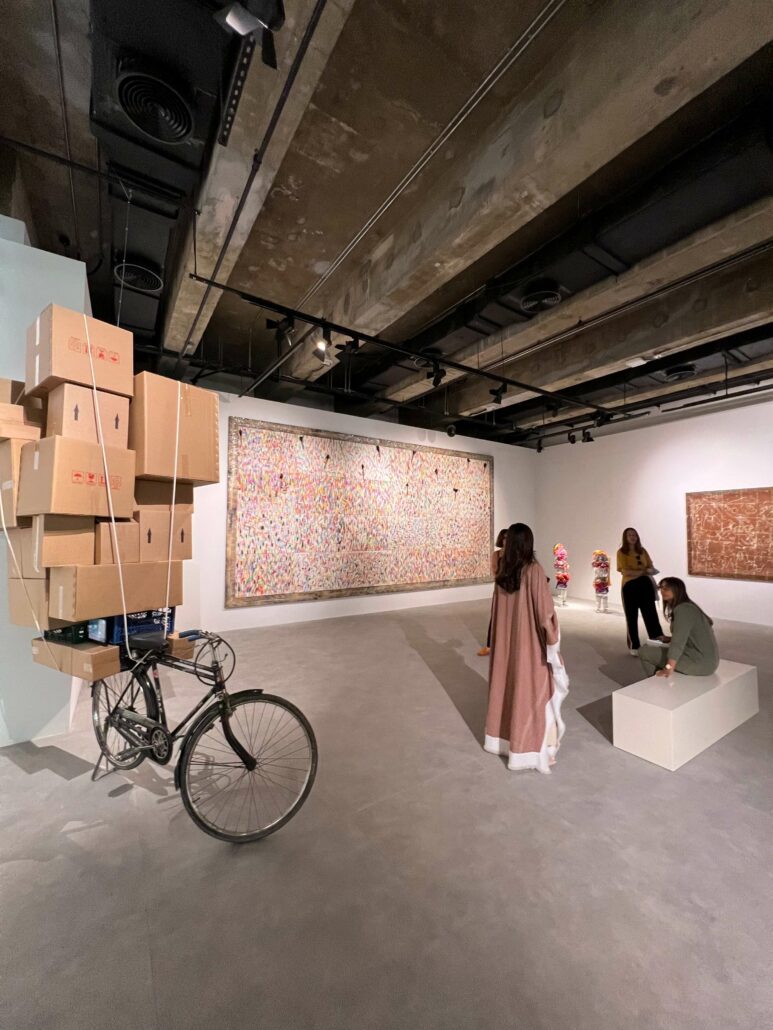
Installation view ‘Fantasia Urbaine’. Image courtesy of Suzette Bell-Roberts
In ‘Playing Field,’ Tayou’s chalk paintings, like works of beaded tapestry, turn assortments of chalk into rhythmic intricate patterns inspired by the traditional West African print fabrics. The artist recalls the use of chalk in street games as well as in school. As a powerful communication tool in the classroom, chalk is a symbol of the fragility of knowledge. “It is an object which is introduced to us from the beginning of our life path.”
Using chalk also prompts examining the reality of the rigid colonial educational system implemented in Cameroon. Today, French is the predominant language taught in schools, while indigenous languages are considered too varied to be implemented within the national curriculum.
These varied assortments of chalks deconstruct such necessities for homogeneity, where Tayou celebrates the multiplicities of language and human expression. At the centre of the room stands the gigantic ‘Africonda’, further exemplifying the dichotomy of Africa’s colonial history. This entangled snake, made of multi-coloured towels, renders a captivating and unsettling visual of Africa to the world.

Pascale Marthine Tayou, Africonda, 2014. Washcloth, mask, dry hay, wood. Image courtesy of Suzette Bell-Roberts
Tayou’s installation ‘Colonne Pascale’ (2023) is made up of pots stacked up into columns along the Cultural Foundation’s waterfront bay. These pots consist of clay pieces sourced from one of the last remaining artisanal pottery studios in the UAE, known for incorporating Indian and Arab Gulf design elements. Also showcased in this installation are colourful painted steel pots, illustrating the iconic geometric patterns prevalent in Gulf Arab households. Much of these clay and steel pot designs are vernacular everyday household items yet have become standardised into mass-produced objects. In this installation, they have accumulated in large quantities that tower over like the buildings surrounding them. This artwork is a collaboration between the artist and the Cultural Foundation.
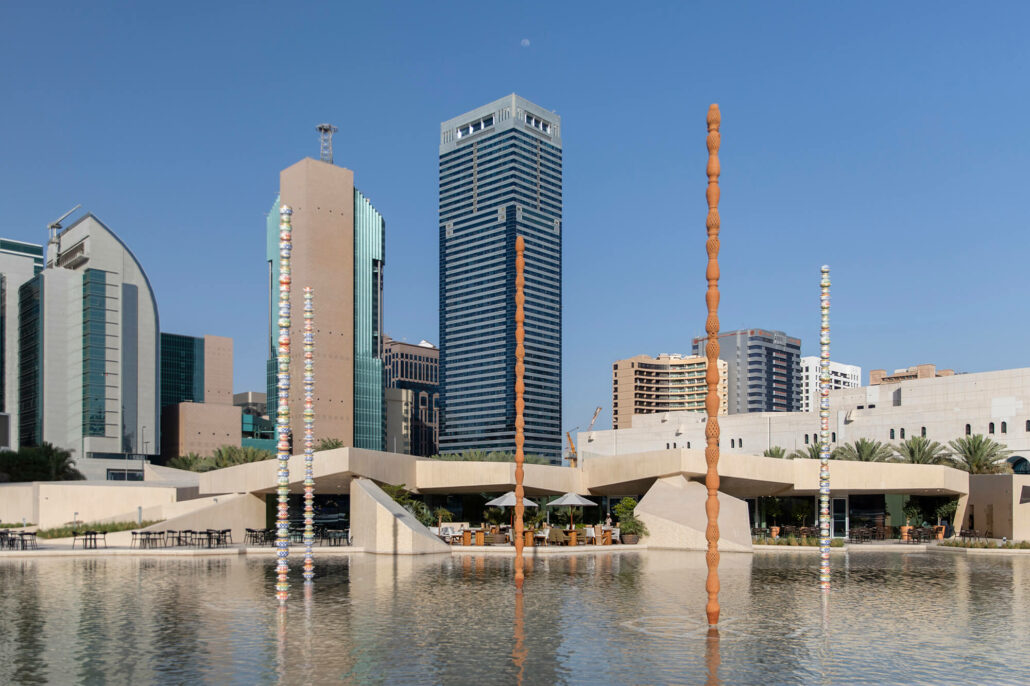
Pascale Marthine Tayou, Colonne Pascale, 2023. Clay and metal pots. Dimensions variable. Courtesy of the artist and GALLERIA CONTINUA. Image courtesy: Cultural Foundation, Department of Culture & Tourism – Abu Dhabi. © ADAGP, Paris
The exhibition is accompanied by a children’s section titled BOBO LAND, which leads young visitors into exploring the self through the eyes of ‘Bobo,’ Tayou’s persona of a dreaming child discovering and inventing their future. With an affinity to childlike inclinations, Tayou’s art philosophy prompts us to approach the harsher realities of our landscape with mischief, amusement, and make-believe.
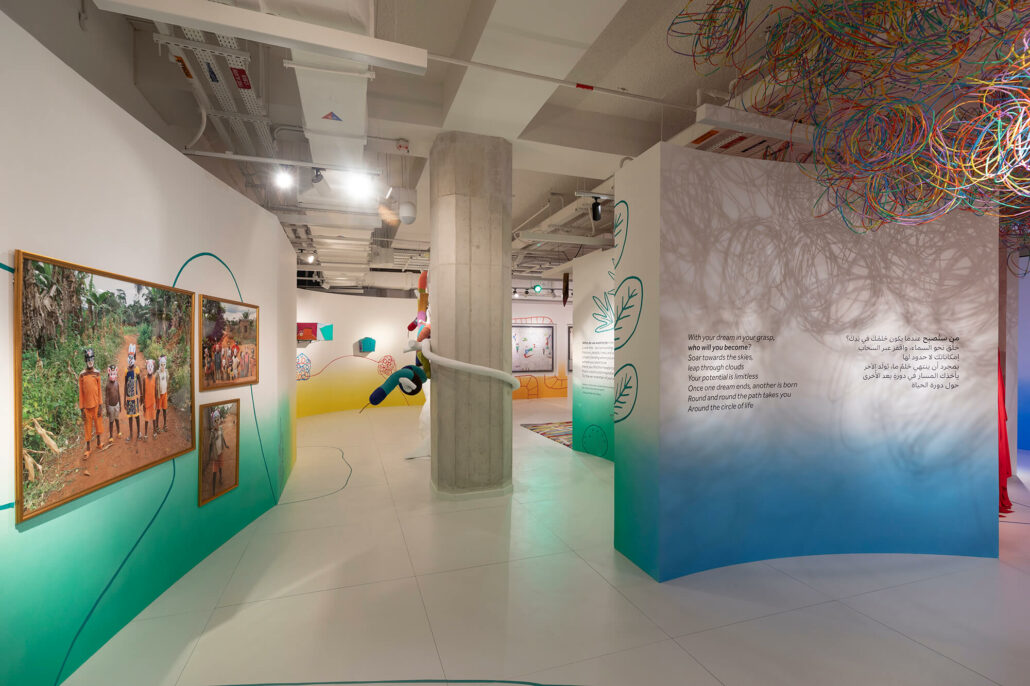
Installation view. ‘BOBO LAND: Pascale Marthine Tayou’. Image courtesy: Cultural Foundation, Department of Culture & Tourism – Abu Dhabi.
Co-curated by Noor Al Mehairbi, Maisa Al Qassimi and Reem Al Hashmi. This exhibition is presented in collaboration with Galleria Continua. The exhibition runs until 26 November 2023 at the Abu Dhabi Cultural Foundation. For more information, please visit the Abu Dhabi Cultural Foundation.
Suzette Bell-Roberts is Co-founder and Digital Editor of ART AFRICA magazine.
